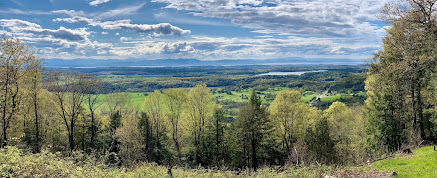May 30.
The morning wind forever blows; the poem of the world is uninterrupted, but few are the ears that hear it.
Forever that strain of the harp which soothed the Cerberus and called me back to life is sounding.
Olympus is the outside of the earth everywhere.
5 A. M. To Cliffs.
High blackberry out.
As I go by Hayden's in the still cool morning, the farmer's door is open — probably his cattle have been attended to — and the odor of the bacon which is being fried for his breakfast fills the air.
The dog lies with his paws hanging over the door-sill this agreeably cool morning.
The cistus out, probably yesterday, a simple and delicate flower, its stamens all swept to one side. It upholds a delicate saffron-golden (?) basin about nine inches from the ground.
As I look off from Fair Haven I perceive that that downy, silvery hoariness has mostly left the leaves (it now comes off on to the clothes), and they are of a uniform smooth light green, while the pines are a dirty dark brown, almost purple, and are mostly merged and lost in the deciduous trees.
The Erigeron bellidifolius is a tender-looking, pale-purple, aster-like flower a foot high in little squads, nodding in the wind on the bare slopes of hill pastures.
Young bush like black cherries a day or two, on Cliffs and in such favorable places.
The hylodes were about done peeping before those last few warm days, — when the toads began in earnest in the river, — but last night being somewhat cooler they were not so loud.
P. M. - To Carlisle Bridge by boat.
A strong but somewhat gusty southerly wind, before which C. and I sailed all the way from home to Carlisle Bridge in not far from an hour; the river unusually high for the season.
Very pleasant to feel the strong, fresh southerly wind from over the water.
There are no clouds in the sky, but a high haziness, as if the moisture drawn up by yesterday's heat was condensed by to-day's comparative coolness.
The water a dull slate-color and waves running high, — a dirty yellow where they break, — and long streaks of white foam, six or eight feet apart, stretching north and south between Concord and Bedford, — without end.
The common blue flag just out at Ball's Hill.
The white maples, especially those shaped like large bushes, on the banks are now full of foliage, showing the white under sides of the leaves in the wind, and the swamp white oak, having similar silvery under sides to its leaves, and both growing abundantly and prevailing here along the river, make or impart a peculiar flashing light to the scenery in windy weather, all bright, flashing, and cheerful.
On the meadows are large yellow-green patches of ferns beginning to prevail.
Passed a large boat anchored off in the meadows not far from the boundary of Concord. It was quite a piece of ocean scenery, we saw it so long before reaching it and so long after; and it looked larger than reality, what with the roaring of the wind in our shrouds and the dashing of the waves. The incessant drifting about of a boat so anchored by a long cable, playing with its halter, now showing more, now less, of its side, is a pleasing sight.
Landed at a high lupine bank by Carlisle Bridge. How many such lupine banks there are! — whose blue you detect many rods off.
There I found, methinks, minute Specularia perfoliata, with small crenate clasping leaves alternate at some distance apart, on upright stems about three inches high, but apparently fruiting in the bud.
Also the Silene antirrhina very abundant there.
The Viola palmata, which is later, and therefore, methinks, fresher than most, is now quite prevalent, one of the most common, in fact, in low ground and a very handsome purple, with more red than usual in its violet.
The pines now dotted with white shoots, the pitch pines a little red dish, are an interesting sight now.
Whence came all those dead suckers, a dozen at least, which we saw floating to-day, some on their sides, transversely barred, some on their backs with their white bellies up and dark fins on each side? Why are they suckers only that we see Can it be because the spearers have thrown them away? Or has some bird of prey dropped them? I rarely see other fish floating.
Melvin gave George Brooks some pink azaleas yesterday, said to have grown in the north part of the town.
The white maple keys falling and covering the river.
H. D. Thoreau, Journal, May 30, 1853
Poem of the world
morning wind forever blows
uninterrupted.














